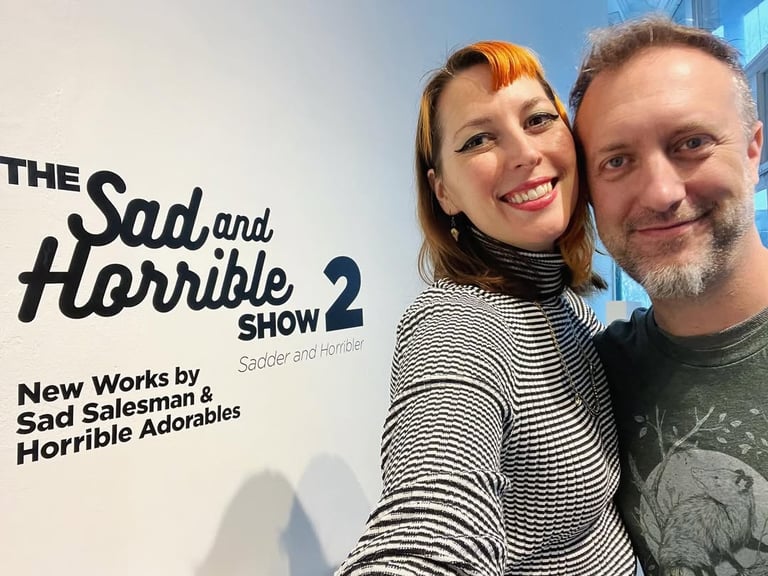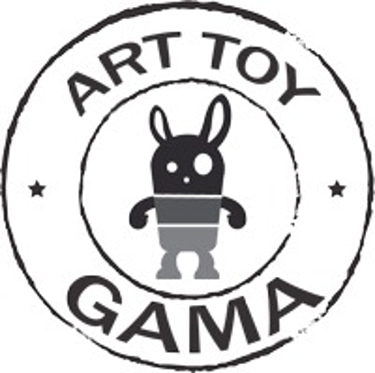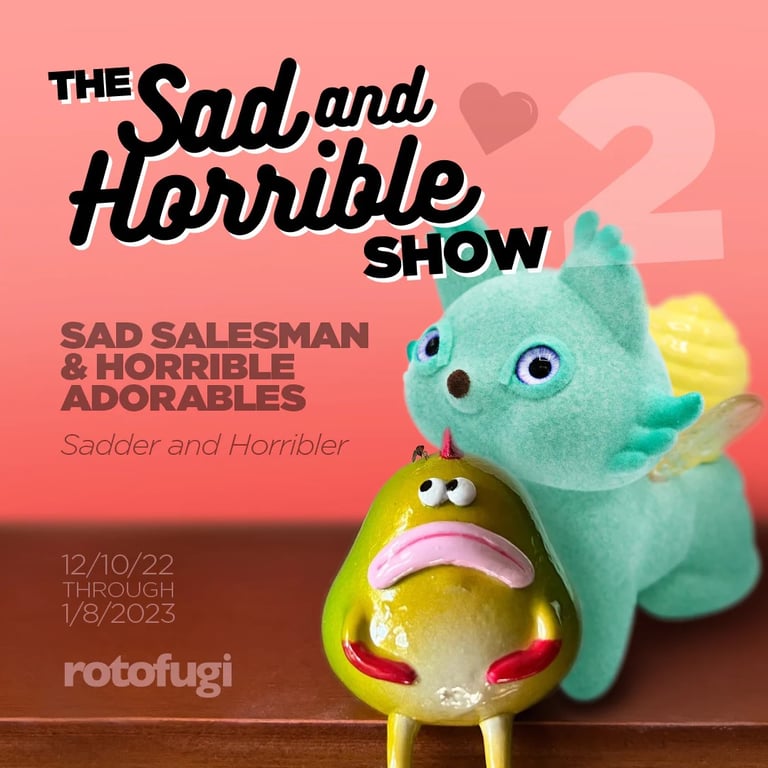We didn’t lose our inner child. We turned it into ArT Toys and More...with purpose.
💔 Sadder, Horribler, Wiser: The Sad and Horrible Show 2
Sad Salesman & Horrible Adorables, Rotofugi, Chicago, 2022–23. The Sad and Horrible Show 2 that mirrored the chaos of COVID-19, #00011—TNoTToys Publications
TNOTTOYS PUBLICATIONS1000 ICONIC ART TOY EXHIBITIONS
Sergio Pampliega Campo & Cristina A. del Chicca
🌀 This post is part of an ongoing research series from Art Toy Gama’s editorial division:
📚 This Is Not a Book About Art Toy Exhibitions & ToyCons
Our Upcoming Art Toy Book: 1000 Iconic ArTToy Exhibitions
Context — A sequel in strange times
Two years after the first Sad & Horrible Show mirrored the chaos of COVID-19, the sequel arrived. December 2022, Rotofugi Gallery. The world wasn’t “healed,” but it was different: cautious, scarred, searching for new ways to reconnect.
So the return made sense. The Sad and Horrible Show 2 — Sadder & Horribler. A title that leaned into excess. A declaration that if the world demanded resilience, artists would answer with humor sharpened by melancholy, tenderness armored with strangeness.
POSTER Reading — What the image really says
The POSTER doesn’t scream tragedy. It whispers play.
A soft gradient pink backdrop, gentler than the hot shock of 2020, frames two characters:
A turquoise winged creature by Horrible Adorables, felt-smooth, eyes wide like a plea wrapped in cuteness.
A green pear-shaped figure by Sad Salesman, mouth sagging in permanent sorrow, hands folded in fragile defeat.
Above them, the number “2” glows, translucent, oversized. A reminder: this is continuation, not repetition. And in the corner, a faint heart—half joke, half confession—says that even sadness deserves affection.
Typography stays bold, Playful, round. The irony lives in the gap between words and visuals: “Sad” and “Horrible” don’t push You away; they invite You closer.
The POSTER, in short, is not a promotion. It’s a promise: you’ll smile at what scares you, you’ll love what looks broken.
What the exhibition showed
Rotofugi turned again into a cabinet of contradictions.
Sad Salesman lined the space with his tragicomic misfits; Surly Fish in variations, resin companions with eyes that accept defeat but still insist on staying alive. Figures that look like failures, sculpted with care, carrying humor in their gloom.
Horrible Adorables responded with a parade of hybrids; soft sculptures layered in felt, pastel yet eerie, cartoonish yet unsettlingly real. Strange animals with horns and wings, but also with recognizably human stances, as if they carried our awkwardness in their stitched skins.
And then came the collabs. When resin met felt, when gloom held hands with whimsy, something new appeared: fragile monsters that felt like they belonged in both a fairy tale and a confession booth.
Collectors didn’t just acquire figures; they acquired fragments of themselves made tangible.
Why it mattered
Because sequels are hard. But this one proved that the dialogue between Sad Salesman and Horrible Adorables was not a one-time spark. It was a formula for survival…articulating emotions that polite culture avoids, but doing it in forms so tender you can’t look away.
Because Rotofugi, by hosting this second chapter, reminded the Movement that galleries are not neutral spaces. They are amplifiers. And in this case, amplifiers of melancholy turned into myth, of monsters that insist on being loved.
Because “Sadder & Horribler” wasn’t just wordplay. It was a cultural mirror. A way of saying: the last years added weight, and art toys can carry that weight with humor, color, and collectibility.
Legacy & Mutation
The Legacy of this second show is persistence. Sad Salesman and Horrible Adorables expanded their universes while deepening their emotional vocabulary. Rotofugi proved again that it curates more than Toys: it curates emotional survival kits.
And the mutation? The language of ArT Toys matured. No longer a novelty, but a ritual. No longer niche, but necessary.
Biography in brief
Eric Althin (Sad Salesman) remains the sculptor of the inner voice we hide, the “little sad salesman” inside everyone. His resin figures don’t fix sadness; they make it lovable.
Jordan Elise Perme and Christopher Lees (Horrible Adorables) remain builders of impossible zoologies. Felt, cut and layered, turned into scales, feathers, pelts. Creatures that are monstrous in form, but tender in presence.
Rotofugi Gallery, still Chicago’s beacon of character Art, reinforced its role: not just a store, but a cultural node where sadness, humor, and handmade myth meet.
Final Thought from Art Toy Gama
From our perspective, this was not simply an exhibition. It was continuity as defiance.
The ArT Toy is not decor. It’s resistance in disguise.
It tells You that melancholy is not weakness. That monsters belong in living rooms. That felt and resin can become mirrors sharper than glass.
At Art Toy Gama, we insist: Dis(Play) is the New Memory. You don’t collect objects; You collect ways of surviving.
👉 Sadder & Horribler proved that sequels can be stronger than first chapters. Because what we really collect is not Toys, it’s the courage to smile at what breaks us.
👉 Join the first and only ArT Toy Newsletter in the world that bites like a rebel, not a press release.
Because what you collect today… is what tomorrow remembers.
#1000IconicArTToyExhibitions
We’re currently building an Upcoming Publication that explores and celebrates
the most iconic and influential Art Toy exhibitions around the world.
Each article in this series helps document, reflect, and invite the community
to take part in constructing this cultural archive — one exhibition at a time.
We’ve seen countless exhibitions since then: small and large, modest and monumental.
And we love them all.
No matter where they take place or the resources behind them,
every ArT Toy show adds something to the Movement.
Some will make history, others will make Memory. All of them matter.
This is not just documentation.
This is Dis(Play) in the making.
And You’re part of it.
Art Toy Gama Legacy
#ArTToyGamaLegacy
Art Toys. Paintings. Fine Art Prints. Not what You expect.
Real collectors don't follow trends—they redefine them


We didn’t lose our inner child. We turned it into Art.
You collecting, or just hoarding what the algorithm spoon-feeds you?
contact
© 2025. All rights reserved.


